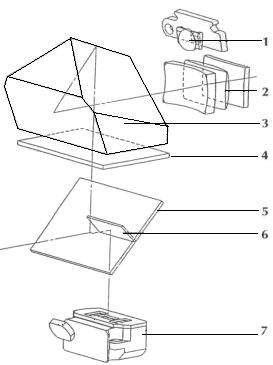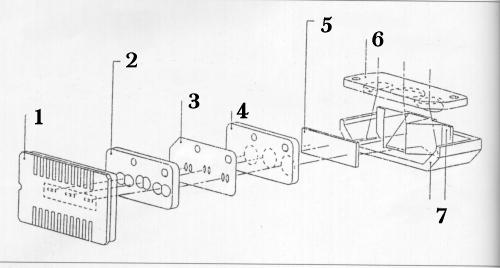Pentax Auto Focus Systems
The KF Mount
This was the very first consumer auto focus system. It consisted of the Pentax ME-F body and the AF35-70/2.8 lens. The AF control electronics were contained inside the body, but the AF motor was inside the lens. Soon this concept was abandoned, and all electronics and the motor were moved inside the body.
The AF operation is as follows. The primary mirror is semi-transparent and lets 35% of the light pass through. Immediately behind it is a secondary mirror that directs all of that 35% of light down through an IR filter and onto an MOS sensor chip. This chip makes all decisions about when an image is in focus or how the lens should move to make the image come into focus.
SAFOX
“SAFOX” stands for Sensor Ability Fortifying Optical Compensating System. It has gone through four revisions, with SAFOX-I being used in the SF series AF bodies, and SAFOX-IV being used in the ZX/MZ bodies. All SAFOX-type lenses are fully compatible with all SAFOX bodies. Basically, this means that the SF, Z/PZ, and ZX/MZ bodies are all compatible with all F and FA lenses.
This system works as follows. The main mirror which is semi-transparent in the middle lets a fixed amount of light pass to a small auxiliary mirror at its back. This mirror redirects the light to a light sensitive CCD-sensor which makes a decision on whether the image is in focus, and then transmits an electrical signal to the auto focus chip. This chip calculates the required amount and direction of rotation of the AF motor. The “in focus” analysis is based on phase detection. The light rays which are deflected by the auxiliary mirror are passed through an infra-red filter and then through a lens system that splits the image in two. If the image is in focus, these two images match. If the lens is focused to far, the two images have a greater distance on the CCD line, if it is focused to narrow these two images have a shorter distance then in the ´zero´ position. Out of this image-, phase-shifting the computer calculates the number and direction of rotations for the auto focus motor. It is not possible to stop right now from a full speed focusing to the exact point. So the speed is reduced before the right focus point is reached. The computer of the camera subdivide the number of turns to reach the right focus point. A photo interrupter in the lens count the impulses and send it back to the camera. The camera compares the actual value with the rated value. A certain steps before the rated value is reached the speed of the auto focus motor is reduced. To the motto "Trust is good — control is better" the computer starts a control measuring.
Translated from the book ´PENTAX MZ-5´ by "Richard Hünecke" Laterna magica. Pictures are from the PENTAX company. From A Busse <abusse@wupperonline.de>
explanations for the picture SAFOX_1
1: silicium-diode from the exposure metering system
2: ocular
3: pentaprism
4: focusing screen
5: main mirror
6: auxiliary mirror
7: auto focus module SAFOX
explanations for the picture SAFOX_2
1: CCD sensor
2: image splitting lens
3: image splitting mask
4: optical correction unit
5: infra red filter
6: condenser lens
7: mirror system
I don´t know the copyright situation of these pictures.
It is said in the book that the pictures are kindly
put at their disposal from the company PENTAX.
SAFOX II is the upgraded of Pentax’s original SAFOX . Light enters through the lens, bounce of the main mirror, is turned 90 degree and is led to the bottom of AF detection point. Then it goes through the Infrared- Cut Filter, Field lens and Image forming lenses to the CCD. SAFOX II’s image Forming lenses are brighter by one stop, and its CCD is twice as sensitive as conventional SAFOX’s.
Z-1 features larger AF frame (3.2 to 4.2 mm in width).
In AF servo mode , when subject movement is faster than 1.5 mm/sec across the film plane, the camera operation is automatically switched to focus prediction mode . It calculates the focusing error and generates signals to control the amount of lens extension to compensate for the error create by the subject’s movement between shutter release and the start of exposure.
From Ronachai Pratanaphon <asirprtn@cmu.chiangmai.ac.th>.


SAFOX II can can splitted into:
SAFOX 2.0 = Z-10 (standard logic and standard motor)
SAFOX 2.1 = Z-1 (standard logic, stronger motor)
SAFOX 2.2 = Z-20/50P (enhanced logic, standard motor)
SAFOX 2.12 = Z-1P (extra enhanced logic and stronger motor)
SAFOX 2.22 = Z-70 (extra enhanced logic, standard motor)
SAFOX IV/V can be splitted into:
SAFOX 4.0 = MZ-5/10/5N (new standard logic, H-sensor, standard motor)
SAFOX 5.0 = MZ-50 (new standard logic, I-sensor, standard motor)
SAFOX 4.1a = MZ-3 (new standard logic, H-sensor, energy saving motor)
SAFOX 4.1b = 645AF (new standard logic, H-sensor, stronger motor)
SAFOX 4.2 = MZ-7 (new enhanced logic, H-sensor, standard motor)
> > SAFOX 4.0 = MZ-5/10/5N (new standard logic, H-sensor, standard motor)
> MZ-5N did better than MZ-10/MZ-5 in certain tests so it should look
> like:
> SAFOX 4.1 MZ-5N - enhanced logic
Unfortunately I have no informations about such changes in the MZ-5N.
It is possible that the logic was slightly improved, and maybe the
motor is a bit different too. Speculations. In any case the
differences are not that spectacular that photo magazines have
written about it. And Pentax themselves concentrated on the wide/spot
option as the new AF feature of the MZ-5N. BTW, I skipped such mode
differences, because the nomenclature becomes more or less senseless
then (every camera would have it's own version).
> > SAFOX 4.1a = MZ-3 (new standard logic, H-sensor, energy saving motor)
> Strange. MZ-3 is almost contemporary with MZ-5N (it appeared on the
> japanese market soon after MZ-5N launch), yet it's been confirmed to have
> better AF by various sources.
Here it is important that the original MZ-5 is still available in the
current japanese lineup, side by side with the MZ-3 (and both in
black and silver). For the export market, Pentax provided a fusion
model (the MZ-5N, only in silver). Some national Pentax distributors
managed to get small contingents of the MZ-3(data) as an additional
offer. But basically MZ-5N and MZ-3 are international market
variations. Major differences in the AF systems are unlikely. The
differences between MZ-3 and MZ-5N that might affect the AF
performance is the general modification of the MZ-3 electronics and
motors for less energy consumption, in order to manage the increased
hunger of the 1/4000s shutter. Also the mirror box has a different
paint for less internal reflections.
> > SAFOX 4.2 = MZ-7 (new enhanced logic, H-sensor, standard motor)
> I'd say almost a new version, very likely with new sensors with
> faster integration cycle in order to cope with flash bursts acting like
> AF assist beam.
Possible. My nomenclature "logic" refers more or less to the complete
electronics, whereas "sensors" means mainly the geometry of the
detecting area, including all front mirrors, filters and prisms.
Since it is Pentax policy to make the detection area geometry the
dominationg factor for AF system designations, I followed this way
too and as long as it's the "H"-shape (formed by mirrors on a
line sensor I should add) with whatever electronics or motor, it's
SAFOX IV for me, whereas the different AF geometry in the MZ-50 is
SAFOX V regardless of the use of 80% of SAFOX IV electronics and
mechanics. IV/V are sister systems anyway, only one year apart.
> SAFOX IV/V can be splitted into:
>
> SAFOX 4.0 = MZ-5/10/5N (new standard logic, H-sensor, standard motor)
MZ-5N did better than MZ-10/MZ-5 in certain tests so it should look
like:
SAFOX 4.1 MZ-5N - enhanced logic
> SAFOX 5.0 = MZ-50 (new standard logic, I-sensor, standard motor)
> SAFOX 4.1a = MZ-3 (new standard logic, H-sensor, energy saving motor)
Strange. MZ-3 is almost contemporary with MZ-5N (it appeared on the
japanese market soon after MZ-5N launch), yet it's been confirmed to have
better AF by various sources.
> SAFOX 4.1b = 645AF (new standard logic, H-sensor, stronger motor)
> SAFOX 4.2 = MZ-7 (new enhanced logic, H-sensor, standard motor)
I'd say almost a new version, very likely with new sensors with
faster integration cycle in order to cope with flash bursts acting like
AF assist beam.
> I will be the first to admit to little or no knowledge regarding SAFOX, and
> I asked this question before and got no response, but my manual for the
> PZ-20 says it has SAFOX III, whatever that is...?
I remember this, but my german Z-20 manual (and all Pentax brochures
I have) clearly says SAFOX II, and this is also true for all
following Z-series models (Z-50P, Z-1P, Z-70). A translation error?
Or a policy change after printing a first edition of manuals?
The main difference between Z-10 and Z-1 and the Z-20 I am aware of
is the improved AF-software of the Z-20.
> >SAFOX 2.1 = Z-1 (standard logic, stronger motor)
> >SAFOX 2.2 = Z-20/50P (enhanced logic, standard motor)
> >SAFOX 2.12 = Z-1P (extra enhanced logic and stronger motor)
> Going from the Z-1 to Z-1p didn't Pentax also claim the sensor
> area had been enlarged by a small amount (20 or 30%)?
This might be possible, but the focussing screens of Z-1 and Z-1P
still show a similar AF frame. Since the Z-1P sensor has a better
light efficiency (I skipped this differences too, you will end up
with more SAFOX versions than cameras then) I think, this also makes
it possible to change the magnification of the projecting lenses,
and enlarging the detection area this way is an option too. Basically
I think Pentax SAFOX versions are constantly updated due to the
available industry moduls for such purposes (CCD-sensors, chips, mini
motors and so on). There is a constant change and improvement of
details. But the general system nomenclature should follow the main
parts that Pentax develops themselves or changes actively in order to
incorporate new features (e.g. firmware, geometry/projection optics,
choice of CCD type, motor and gear dimensioning).
It is possible too that Pentax marketing tells different stories than
engineers would do.